How does an Italian man end up living in the West Kerry Gaeltacht speaking the most beautiful fluent Irish?
Well, it involves violins, Vikings and a trip to the Feakle Festival – alongside many linguistic elements, of course.
This is the story of Andrea Palandri, Helen Nic Aodha and babaí Bríd.
Italy and Scotland
Andrea’s father is Italian and his mother is Scottish. His parents met in London, where his mother was attending university and his father was a junior lecturer, teaching Italian.
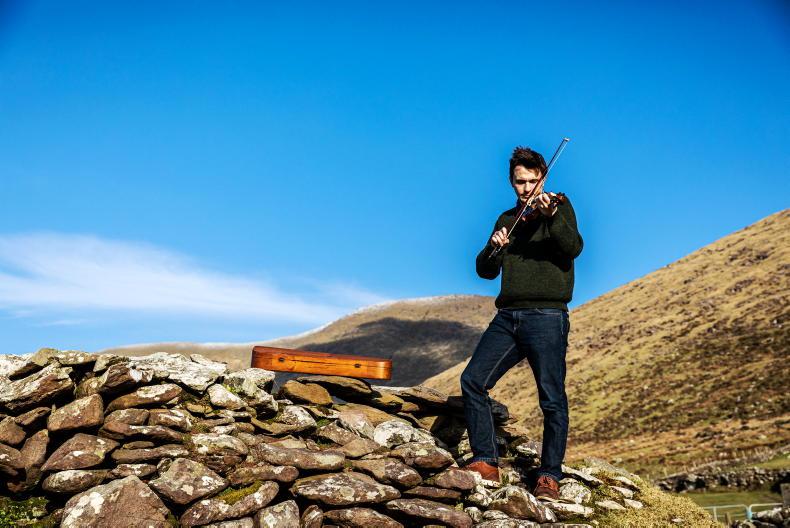
Andrea was born in Italy, but grew up in London until the age of nine, when the family moved to Venice. After school Andrea returned to England for university.
Growing up – as you’ve probably already guessed – he was bilingual, speaking Italian to his father and English to his mother.
But still, I hear you ask, where does Irish come into all this?
Well, there are two main factors– music and his lifelong interest in the evolution of European languages.
Let’s start with music.
Andrea began playing the classical violin at just four, but by the time he reached his late childhood years, his interest began to wane.
“I lost interest by the age of 12, like a lot of kids,” Andrea explains. “When I was around 14 my mother said, ‘Why don’t you go off to Scotland, stay with my sister and you can go to this traditional Scottish music course?’ As a kid I liked Aly Bain and Phil Cunningham [Scottish traditional musicians] a lot. I went and I loved it.
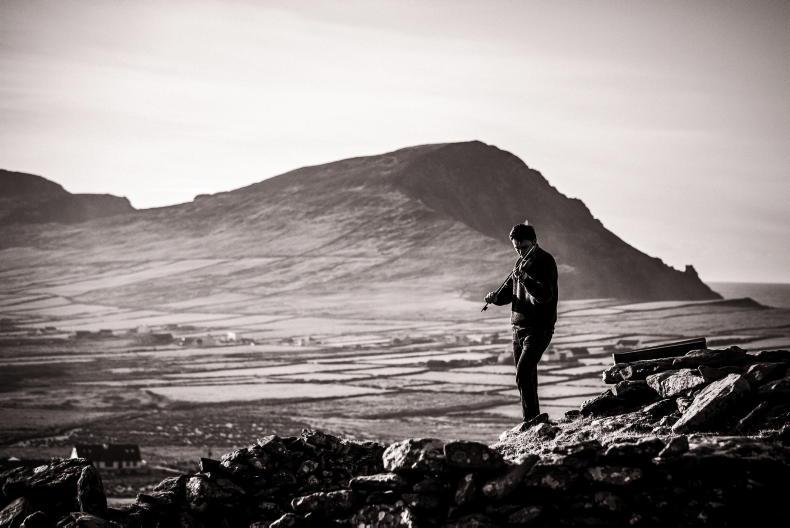
Andrea Palandri first became interested in the Irish language through his love of traditional Irish music. \ Philip Doyle
“I befriended a fella from Glasgow, who had Gweedore connections. He was playing all these Irish tunes. I just thought it was brilliant and I was asking him about it all the time. He told me to listen to Irish music.
“I’d basically gone off from a Scottish traditional music course and came back the following year just knowing Irish tunes. I had spent a year on the website thesession.org learning traditional Irish music.”
From there, Andrea’s interest in Irish trad grew.
It’s important to note that during this time, Andrea’s interest in languages was growing in tandem with his Irish musical interests. 
In school in Italy he learned both Latin and Greek. As a native Italian speaker, he was interested in how Italian was derived from Latin. They also studied etymology in school – the history of words and where they are derived from. This was (and still is) a big area of interest of Andrea’s.
In these developmental years, Andrea was also reading Icelandic sagas that dealt with stories of Vikings and medieval Europe. This sparked an interest in Old Norse, a language spoken up to the 14th century from which the Scandinavian languages are derived.
All this is important to show the depth of Andrea’s linguistic interests; but back to music, Ireland and Andrea’s teenage exploration of trad.
Ireland
“I started listening to Martin Hayes, who is a fiddle player from Feakle, Co Clare,” Andrea recalls. “At 17 I said, ‘I’d love to go to the festival in his town in Ireland, that’d be great.’ My dad said, ‘Here’s €200, I’ll buy you the tickets.’ I had the €200 spent within the first day, I think. I spent the rest of the time eating crisps and asking people for pints.”
“That’s the Scottish side coming out,” interjects Helen, Andrea’s fiancée, with light-hearted humour.
Andrea takes up the tale of his first foray in Ireland again.
“I was going camping at the Feakle Festival. I didn’t know how I was going to get there from the airport. I landed in Shannon and I managed to get a lift,” he says.
“I sat into this car and I remember looking at the road signs and seeing they were bilingual. From school I had some tools to analyse the history of language.”
Instinctively, Andrea was interested in the root of the words he saw. He gives the example of the Irish word “teampall”, “temple” in English and “templum” in Latin. He was interested in the fact that they all had the same European root. This is the case for many words.
And then of course, there was plenty of craic agus ceol in Feakle.
“There was one night in Pepper’s Pub in Feakle with Saileog Ní Cheannabháin – who’s a singer from Dublin, but her father’s from Connemara – and the Begleys. They were doing their Begley Show throwing boxes around and playing tunes, Saileog was singing and there was lots of Irish being spoken,” Andrea says.
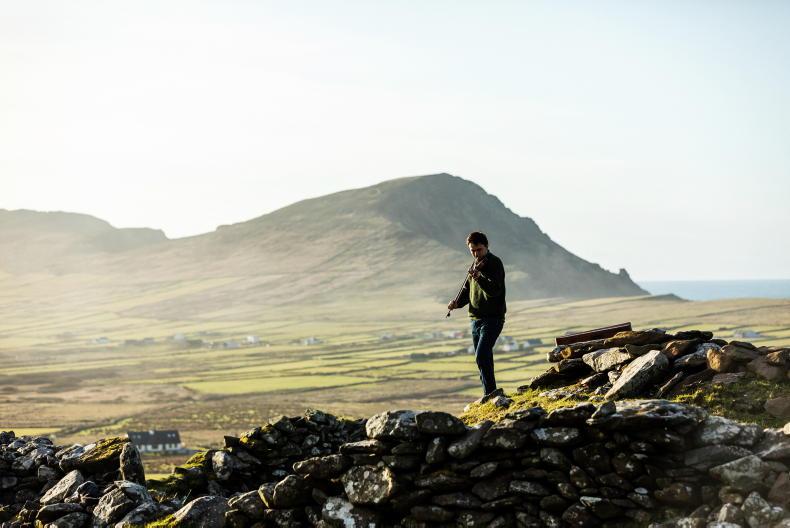
“Obviously, I couldn’t make out a word, but I was thinking, ‘What’s going on? What is the linguistic makeup of this country that I’ve just landed in? Some people are speaking Irish, some people aren’t. Most people are speaking English, but all the road sings are in Irish and English. All the tunes names are in Irish. So what’s happening?’”
After finishing school in Italy, Andrea went to Cambridge to study a course that combined Old English, Old Norse, Old Welsh, Old Irish and medieval history. Quite early on in the course he became particularly interested the Irish side of things.
One specific moment that piqued his interest was reading Sweeney Astray, an English translation of an old Irish text, Buile Shuibhne, retranslated in recent times by Seamus Heaney. After this he began taking an evening class in modern Irish.

Andrea Palandri's father is Italian and his mother is Scottish. \ Philip Doyle
After completing his degree, Andrea began an Irish PhD in University College Cork (UCC) from 2014 to 2018. His PhD topic encapsulated both his Irish interests and Italian identity. It focused on a manuscript from the 15th Century, an Irish translation from Latin about Venetian traveller Marco Polo.
In the meantime he met Helen.
Leitrim and Mayo
Helen is from Leitrim. She always had an interest in Irish through school and going to the Gaeltacht as a teenager. 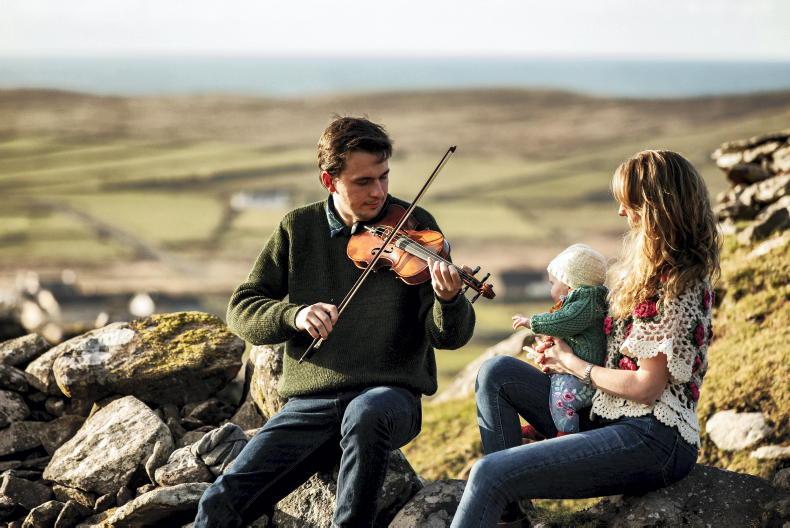
She decided to study German instead of Irish in university, but with the intention of returning to Irish in the future.
“I felt like I had a good base in Irish already and I could revisit it at some stage when the moment would strike,” Helen explains. “The moment struck in the form of an Italian with fluent Irish, much better Irish than I had. So if anything was going to give me inspiration to start learning Irish again, it was that.”
As well as speaking with Andrea, Helen began listening to recordings as Gaeilge from the National Folklore Collection. She took a particular interest in Mayo Irish, as “it would be the closest to what would have been spoken in Leitrim”.
Off her own bat, Helen began travelling to the Mayo Gaeltacht, getting to know people and speaking Irish with them.
In 2018, Andrea and Helen moved to the parish of Cill Chuáin, 15 minutes outside Dingle in the West Kerry Gaeltacht for a summer. They then both got jobs in Dublin with Irish elements and moved there.
Andrea took up a job as a postdoctoral researcher in the Dublin Institute for Advanced Studies. Helen got a job with University College Dublin (UCD). She then went on to undertake a Master’s in Irish there. She is finishing this at present, as she had a happy interruption in the form of babaí Bríd.
“Being up in Mayo a lot and knowing the National Folklore Connection had a real lack of female speakers, led to my master’s topic,” Helen explains. “I’m doing a master’s that’s focusing on female speakers in the Ceathrú Thaidhg area of Mayo, specifically on the language mothers use with children of all ages.

“Putting together a vocabulary of terms so that people who want to bring their kids up with Irish have this. And also to have the voices of women from that area recorded forever more and available to people through the National Folklore Collection.”
Ciarraí
Around October 2020, having worked from a Dublin flat throughout the first COVID-19 lockdown, Andrea and Helen decided to move back to Cill Chuáin in west Kerry. They found a house to rent and are there since, plus the addition of Bríd, who gurgles contentedly as we chat in the kitchen looking out at the sea.
Andrea speaks with as strong a Kerry accent as just about anyone around. He is now working remotely with UCD in digitising Irish manuscripts from the National Folklore Collection.

I’m sure at this point you don’t need me to tell you that Andrea and Helen are both very passionate about the Irish language. Bríd is being brought up speaking Italian with Andrea and Irish with Helen, naturally picking up English along the way as she grows up. Moving to the Gaeltacht has been a very positive experience for them, but it has also highlighted the challenges of accessing services in Irish, such as childcare, which is just one example they give.
“You can make all the effort at home,” Andrea says, “get a PhD and a master’s in Irish.”
“And move to the Gaeltacht,” Helen adds.
“If you are both going to work you need childcare,” Andrea continues, “You are putting all that work in yourself and then there’s no basic facilities around that are supporting what you are trying to support. Suddenly you’re really fending for yourself.
“That’s our challenge at the moment. There’s a crèche in this parish, but it’s only from two years up. There is that, but that’s not what we’re looking for at the moment.”
That said, they speak at length about the great sense of community in the area. Helen says she feels very at home.
“I feel very comfortable here being from Leitrim. The sort of way of life, the pace of life, is very similar. Here probably has something extra that I don’t think we have any more in Leitrim,” Helen explains.
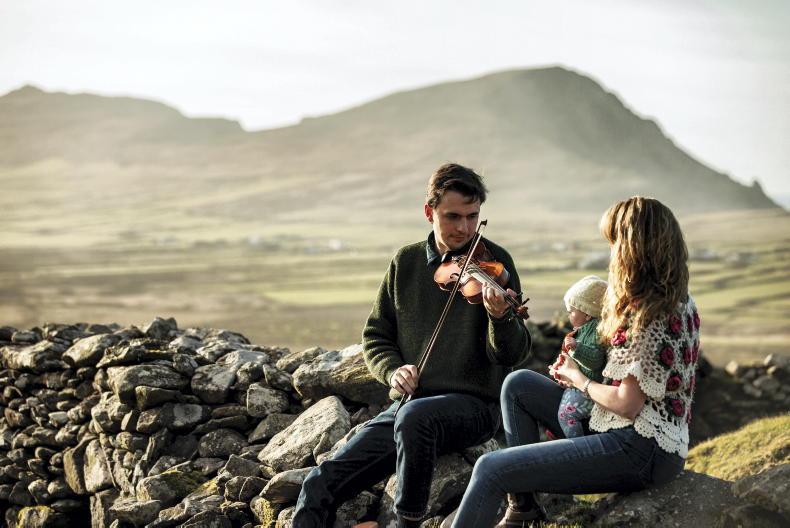
“Nowadays in other parts of Ireland and rural Ireland you might feel like you have to give a call ahead to drop into someone, whereas here it’s very much still in vogue that people drop in unannounced.
“Within two hours of moving down here we had five callers. That’s not a joke. When we had Bríd, suddenly people that we had only known by name were coming to the door with cards and presents. There were offers of babysitting. The hospitality that was already so strong blew up even more.”
Going forward, Andrea and Helen hope to get a place of their own and settle in the area. Their contribution to Irish as a living, community language.
So, that’s the story of an Italian man, plus his partner and their baby, coming to live in the West Kerry Gaeltacht with the most beautiful fluent Irish.
Read more
Brothers in arms: music, rural life and Gaeilge with the Ó Beaglaoichs
Podcast: Franz Sauerland on Gaeilge, football and experiencing racial abuse
How does an Italian man end up living in the West Kerry Gaeltacht speaking the most beautiful fluent Irish?
Well, it involves violins, Vikings and a trip to the Feakle Festival – alongside many linguistic elements, of course.
This is the story of Andrea Palandri, Helen Nic Aodha and babaí Bríd.
Italy and Scotland
Andrea’s father is Italian and his mother is Scottish. His parents met in London, where his mother was attending university and his father was a junior lecturer, teaching Italian.

Andrea was born in Italy, but grew up in London until the age of nine, when the family moved to Venice. After school Andrea returned to England for university.
Growing up – as you’ve probably already guessed – he was bilingual, speaking Italian to his father and English to his mother.
But still, I hear you ask, where does Irish come into all this?
Well, there are two main factors– music and his lifelong interest in the evolution of European languages.
Let’s start with music.
Andrea began playing the classical violin at just four, but by the time he reached his late childhood years, his interest began to wane.
“I lost interest by the age of 12, like a lot of kids,” Andrea explains. “When I was around 14 my mother said, ‘Why don’t you go off to Scotland, stay with my sister and you can go to this traditional Scottish music course?’ As a kid I liked Aly Bain and Phil Cunningham [Scottish traditional musicians] a lot. I went and I loved it.

Andrea Palandri first became interested in the Irish language through his love of traditional Irish music. \ Philip Doyle
“I befriended a fella from Glasgow, who had Gweedore connections. He was playing all these Irish tunes. I just thought it was brilliant and I was asking him about it all the time. He told me to listen to Irish music.
“I’d basically gone off from a Scottish traditional music course and came back the following year just knowing Irish tunes. I had spent a year on the website thesession.org learning traditional Irish music.”
From there, Andrea’s interest in Irish trad grew.
It’s important to note that during this time, Andrea’s interest in languages was growing in tandem with his Irish musical interests. 
In school in Italy he learned both Latin and Greek. As a native Italian speaker, he was interested in how Italian was derived from Latin. They also studied etymology in school – the history of words and where they are derived from. This was (and still is) a big area of interest of Andrea’s.
In these developmental years, Andrea was also reading Icelandic sagas that dealt with stories of Vikings and medieval Europe. This sparked an interest in Old Norse, a language spoken up to the 14th century from which the Scandinavian languages are derived.
All this is important to show the depth of Andrea’s linguistic interests; but back to music, Ireland and Andrea’s teenage exploration of trad.
Ireland
“I started listening to Martin Hayes, who is a fiddle player from Feakle, Co Clare,” Andrea recalls. “At 17 I said, ‘I’d love to go to the festival in his town in Ireland, that’d be great.’ My dad said, ‘Here’s €200, I’ll buy you the tickets.’ I had the €200 spent within the first day, I think. I spent the rest of the time eating crisps and asking people for pints.”
“That’s the Scottish side coming out,” interjects Helen, Andrea’s fiancée, with light-hearted humour.
Andrea takes up the tale of his first foray in Ireland again.
“I was going camping at the Feakle Festival. I didn’t know how I was going to get there from the airport. I landed in Shannon and I managed to get a lift,” he says.
“I sat into this car and I remember looking at the road signs and seeing they were bilingual. From school I had some tools to analyse the history of language.”
Instinctively, Andrea was interested in the root of the words he saw. He gives the example of the Irish word “teampall”, “temple” in English and “templum” in Latin. He was interested in the fact that they all had the same European root. This is the case for many words.
And then of course, there was plenty of craic agus ceol in Feakle.
“There was one night in Pepper’s Pub in Feakle with Saileog Ní Cheannabháin – who’s a singer from Dublin, but her father’s from Connemara – and the Begleys. They were doing their Begley Show throwing boxes around and playing tunes, Saileog was singing and there was lots of Irish being spoken,” Andrea says.

“Obviously, I couldn’t make out a word, but I was thinking, ‘What’s going on? What is the linguistic makeup of this country that I’ve just landed in? Some people are speaking Irish, some people aren’t. Most people are speaking English, but all the road sings are in Irish and English. All the tunes names are in Irish. So what’s happening?’”
After finishing school in Italy, Andrea went to Cambridge to study a course that combined Old English, Old Norse, Old Welsh, Old Irish and medieval history. Quite early on in the course he became particularly interested the Irish side of things.
One specific moment that piqued his interest was reading Sweeney Astray, an English translation of an old Irish text, Buile Shuibhne, retranslated in recent times by Seamus Heaney. After this he began taking an evening class in modern Irish.

Andrea Palandri's father is Italian and his mother is Scottish. \ Philip Doyle
After completing his degree, Andrea began an Irish PhD in University College Cork (UCC) from 2014 to 2018. His PhD topic encapsulated both his Irish interests and Italian identity. It focused on a manuscript from the 15th Century, an Irish translation from Latin about Venetian traveller Marco Polo.
In the meantime he met Helen.
Leitrim and Mayo
Helen is from Leitrim. She always had an interest in Irish through school and going to the Gaeltacht as a teenager. 
She decided to study German instead of Irish in university, but with the intention of returning to Irish in the future.
“I felt like I had a good base in Irish already and I could revisit it at some stage when the moment would strike,” Helen explains. “The moment struck in the form of an Italian with fluent Irish, much better Irish than I had. So if anything was going to give me inspiration to start learning Irish again, it was that.”
As well as speaking with Andrea, Helen began listening to recordings as Gaeilge from the National Folklore Collection. She took a particular interest in Mayo Irish, as “it would be the closest to what would have been spoken in Leitrim”.
Off her own bat, Helen began travelling to the Mayo Gaeltacht, getting to know people and speaking Irish with them.
In 2018, Andrea and Helen moved to the parish of Cill Chuáin, 15 minutes outside Dingle in the West Kerry Gaeltacht for a summer. They then both got jobs in Dublin with Irish elements and moved there.
Andrea took up a job as a postdoctoral researcher in the Dublin Institute for Advanced Studies. Helen got a job with University College Dublin (UCD). She then went on to undertake a Master’s in Irish there. She is finishing this at present, as she had a happy interruption in the form of babaí Bríd.
“Being up in Mayo a lot and knowing the National Folklore Connection had a real lack of female speakers, led to my master’s topic,” Helen explains. “I’m doing a master’s that’s focusing on female speakers in the Ceathrú Thaidhg area of Mayo, specifically on the language mothers use with children of all ages.

“Putting together a vocabulary of terms so that people who want to bring their kids up with Irish have this. And also to have the voices of women from that area recorded forever more and available to people through the National Folklore Collection.”
Ciarraí
Around October 2020, having worked from a Dublin flat throughout the first COVID-19 lockdown, Andrea and Helen decided to move back to Cill Chuáin in west Kerry. They found a house to rent and are there since, plus the addition of Bríd, who gurgles contentedly as we chat in the kitchen looking out at the sea.
Andrea speaks with as strong a Kerry accent as just about anyone around. He is now working remotely with UCD in digitising Irish manuscripts from the National Folklore Collection.

I’m sure at this point you don’t need me to tell you that Andrea and Helen are both very passionate about the Irish language. Bríd is being brought up speaking Italian with Andrea and Irish with Helen, naturally picking up English along the way as she grows up. Moving to the Gaeltacht has been a very positive experience for them, but it has also highlighted the challenges of accessing services in Irish, such as childcare, which is just one example they give.
“You can make all the effort at home,” Andrea says, “get a PhD and a master’s in Irish.”
“And move to the Gaeltacht,” Helen adds.
“If you are both going to work you need childcare,” Andrea continues, “You are putting all that work in yourself and then there’s no basic facilities around that are supporting what you are trying to support. Suddenly you’re really fending for yourself.
“That’s our challenge at the moment. There’s a crèche in this parish, but it’s only from two years up. There is that, but that’s not what we’re looking for at the moment.”
That said, they speak at length about the great sense of community in the area. Helen says she feels very at home.
“I feel very comfortable here being from Leitrim. The sort of way of life, the pace of life, is very similar. Here probably has something extra that I don’t think we have any more in Leitrim,” Helen explains.

“Nowadays in other parts of Ireland and rural Ireland you might feel like you have to give a call ahead to drop into someone, whereas here it’s very much still in vogue that people drop in unannounced.
“Within two hours of moving down here we had five callers. That’s not a joke. When we had Bríd, suddenly people that we had only known by name were coming to the door with cards and presents. There were offers of babysitting. The hospitality that was already so strong blew up even more.”
Going forward, Andrea and Helen hope to get a place of their own and settle in the area. Their contribution to Irish as a living, community language.
So, that’s the story of an Italian man, plus his partner and their baby, coming to live in the West Kerry Gaeltacht with the most beautiful fluent Irish.
Read more
Brothers in arms: music, rural life and Gaeilge with the Ó Beaglaoichs
Podcast: Franz Sauerland on Gaeilge, football and experiencing racial abuse
















 This is a subscriber-only article
This is a subscriber-only article












SHARING OPTIONS: